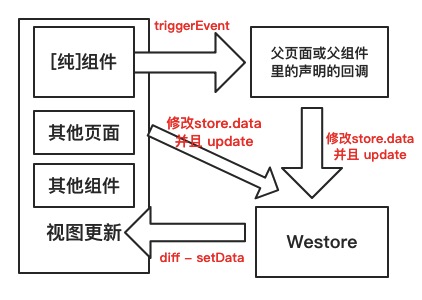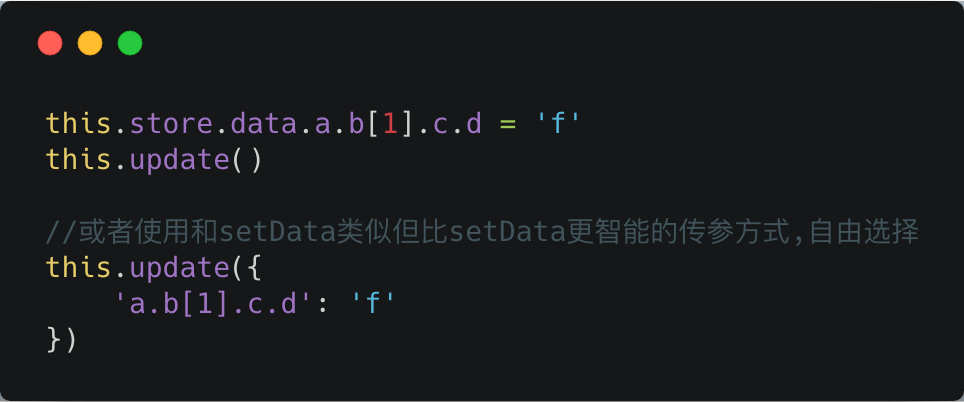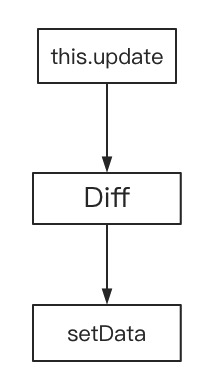小程式解決方案 Westore
阿新 • • 發佈:2018-12-14
## 資料流轉
先上一張圖看清 Westore 怎麼解決小程式資料難以管理和維護的問題:

非純元件的話,可以直接省去 triggerEvent 的過程,直接修改 store.data 並且 update,形成縮減版單向資料流。
[Github: https://github.com/dntzhang/westore](https://github.com/dntzhang/westore)
## 元件
這裡說的元件便是自定義元件,使用原生小程式的開發格式如下:
```js
Component({
properties: { },
data: { },
methods: { }
})
```
使用 Westore 之後:
```js
import create from '../../utils/create'
create({
properties: { },
data: { },
methods: { }
})
```
看著差別不大,但是區別:
* Component 的方式使用 setData 更新檢視
* create 的方式直接更改 store.data 然後呼叫 update
* create 的方式可以使用函式屬性,Component 不可以,如:
```js
export default {
data: {
firstName: 'dnt',
lastName: 'zhang',
fullName:function(){
return this.firstName + this.lastName
}
}
}
```
繫結到檢視:
```jsx
{{fullName}}
```
小程式 setData 的痛點:
* 使用 this.data 可以獲取內部資料和屬性值,但不要直接修改它們,應使用 setData 修改
* setData 程式設計體驗不好,很多場景直接賦值更加直觀方便
* setData 卡卡卡慢慢慢,JsCore 和 Webview 資料物件來回傳浪費計算資源和記憶體資源
* 元件間通訊或跨頁通訊會把程式搞得亂七八糟,變得極難維護和擴充套件
沒使用 westore 的時候經常可以看到這樣的程式碼:

使用完 westore 之後:

上面兩種方式也可以混合使用。
可以看到,westore 不僅支援直接賦值,而且 this.update 相容了 this.setData 的語法,但效能大大優於 this.setData,再舉個例子:
``` js
this.store.data.motto = 'Hello Westore'
this.store.data.b.arr.push({ name: 'ccc' })
this.update()
```
等同於
``` js
this.update({
motto:'Hello Westore',
[`b.arr[${this.store.data.b.arr.length}]`]:{name:'ccc'}
})
```
這裡需要特別強調,雖然 this.update 可以相容小程式的 this.setData 的方式傳參,但是更加智慧,this.update 會先 Diff 然後 setData。原理:

## 純元件
常見純元件由很多,如 tip、alert、dialog、pager、日曆等,與業務資料無直接耦合關係。
元件的顯示狀態由傳入的 props 決定,與外界的通訊通過內部 triggerEvent 暴露的回撥。
triggerEvent 的回撥函式可以改變全域性狀態,實現單向資料流同步所有狀態給其他兄弟、堂兄、姑姑等元件或者其他頁面。
Westore裡可以使用 `create({ pure: true })` 建立純元件(當然也可以直接使用 Component),比如 :
```js
import create from '../../utils/create'
create({
pure : true,
properties: {
text: {
type: String,
value: '',
observer(newValue, oldValue) { }
}
},
data: {
privateData: 'privateData'
},
ready: function () {
console.log(this.properties.text)
},
methods: {
onTap: function(){
this.store.data.privateData = '成功修改 privateData'
this.update()
this.triggerEvent('random', {rd:'成功發起單向資料流' + Math.floor( Math.random()*1000)})
}
}
})
```
需要注意的是,加上 `pure : true` 之後就是純元件,元件的 data 不會被合併到全域性的 store.data 上。
元件區分業務元件和純元件,他們的區別如下:
* 業務元件與業務資料緊耦合,換一個專案可能該元件就用不上,除非非常類似的專案
* 業務元件通過 store 獲得所需引數,通過更改 store 與外界通訊
* 業務元件也可以通過 props 獲得所需引數,通過 triggerEvent 與外界通訊
* 純元件與業務資料無關,可移植和複用
* 純元件只能通過 props 獲得所需引數,通過 triggerEvent 與外界通訊
大型專案一定會包含純元件、業務元件。通過純元件,可以很好理解單向資料流。
## 小程式外掛

小程式外掛是對一組 JS 介面、自定義元件或頁面的封裝,用於嵌入到小程式中使用。外掛不能獨立執行,必須嵌入在其他小程式中才能被使用者使用;而第三方小程式在使用外掛時,也無法看到外掛的程式碼。因此,外掛適合用來封裝自己的功能或服務,提供給第三方小程式進行展示和使用。
外掛開發者可以像開發小程式一樣編寫一個外掛並上傳程式碼,在外掛釋出之後,其他小程式方可呼叫。小程式平臺會託管外掛程式碼,其他小程式呼叫時,上傳的外掛程式碼會隨小程式一起下載執行。
* [外掛開發者文件](https://developers.weixin.qq.com/miniprogram/dev/framework/plugin/development.html)
* [外掛使用者文件](https://developers.weixin.qq.com/miniprogram/dev/framework/plugin/using.html)
### 外掛開發
Westore 提供的目錄如下:
```
|--components
|--westore
|--plugin.json
|--store.js
```
建立外掛:
```js
import create from '../../westore/create-plugin'
import store from '../../store'
//最外層容器節點需要傳入 store,其他元件不傳 store
create(store, {
properties:{
authKey:{
type: String,
value: ''
}
},
data: { list: [] },
attached: function () {
// 可以得到外掛上宣告傳遞過來的屬性值
console.log(this.properties.authKey)
// 監聽所有變化
this.store.onChange = (detail) => {
this.triggerEvent('listChange', detail)
}
// 可以在這裡發起網路請求獲取外掛的資料
this.store.data.list = [{
name: '電視',
price: 1000
}, {
name: '電腦',
price: 4000
}, {
name: '手機',
price: 3000
}]
this.update()
//同樣也直接和相容 setData 語法
this.update(
{ 'list[2].price': 100000 }
)
}
})
```
在你的小程式中使用元件:
```js
```
這裡來梳理下小程式自定義元件外掛怎麼和使用它的小程式通訊:
* 通過 properties 傳入更新外掛,通過 properties 的 observer 來更新外掛
* 通過 store.onChange 收集 data 的所有變更
* 通過 triggerEvent 來拋事件給使用外掛外部的小程式
這麼方便簡潔還不趕緊試試 [Westore外掛開發模板](https://github.com/dntzhang/westore/tree/master/packages/westore-plugin) !
### 特別強調
外掛內所有元件公用的 store 和外掛外小程式的 store 是相互隔離的。
### 原理
#### 頁面生命週期函式
| 名稱 | 描述 |
| ------ | ------ |
| onLoad | 監聽頁面載入 |
| onShow | 監聽頁面顯示 |
| onReady | 監聽頁面初次渲染完成 |
| onHide | 監聽頁面隱藏 |
| onUnload | 監聽頁面解除安裝 |
#### 元件生命週期函式
| 名稱 | 描述 |
| ------ | ------ |
| created | 在元件例項進入頁面節點樹時執行,注意此時不能呼叫 setData |
| attached | 在元件例項進入頁面節點樹時執行 |
| ready | 在元件佈局完成後執行,此時可以獲取節點資訊(使用 SelectorQuery ) |
| moved | 在元件例項被移動到節點樹另一個位置時執行 |
| detached | 在元件例項被從頁面節點樹移除時執行 |
由於開發外掛時候的元件沒有 this.page,所以 store 是從根元件注入,而且可以在 attached 提前注入:
``` js
export default function create(store, option) {
let opt = store
if (option) {
opt = option
originData = JSON.parse(JSON.stringify(store.data))
globalStore = store
globalStore.instances = []
create.store = globalStore
}
const attached = opt.attached
opt.attached = function () {
this.store = globalStore
this.store.data = Object.assign(globalStore.data, opt.data)
this.setData.call(this, this.store.data)
globalStore.instances.push(this)
rewriteUpdate(this)
attached && attached.call(this)
}
Component(opt)
}
```
## 總結
* 元件 - 對 WXML、WXSS 和 JS 的封裝,與業務耦合,可複用,難移植
* 純元件 - 對 WXML、WXSS 和 JS 的封裝,與業務解耦,可複用,易移植
* 外掛 - 小程式外掛是對一組 JS 介面、自定義元件或頁面的封裝,與業務耦合,可複用
## Star & Fork 小程式解決方案
[https://github.com/dntzhang/westore](https://github.com/dntzhang/westore)
## License
MIT [@dntzhang](https://github.com/dntzhang)
